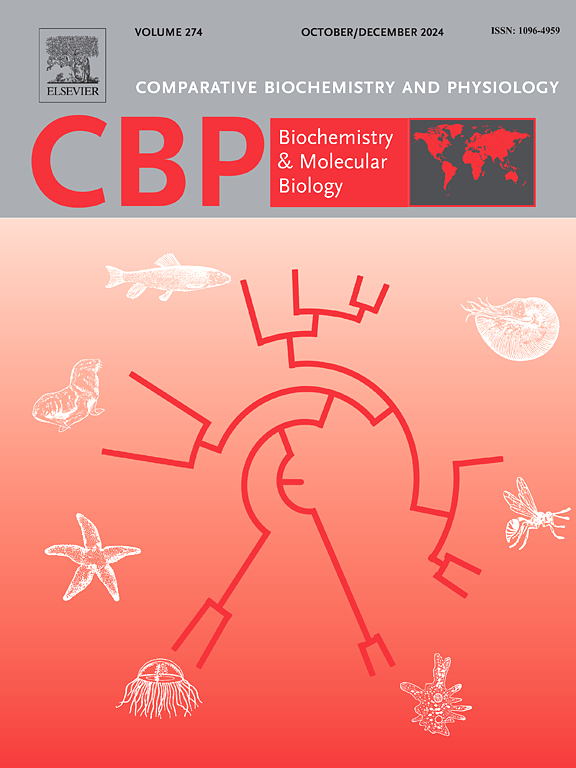Integrated yeast one-hybrid and molecular docking reveal the binding specificity of FTZ-F1 to GnRHR and Dmrta2 promoters in the scallop, Chlamys farreri
IF 1.8
3区 生物学
Q4 BIOCHEMISTRY & MOLECULAR BIOLOGY
Comparative Biochemistry and Physiology B-Biochemistry & Molecular Biology
Pub Date : 2025-08-23
DOI:10.1016/j.cbpb.2025.111149
引用次数: 0
Abstract
The scallop (Chlamys farreri) is an important aquaculture species, and understanding its reproductive regulation is a major research focus. Previous studies have suggested that the orphan nuclear receptor fushi tarazu factor 1 (FTZ![]() F1), a member of the nuclear receptor subfamily 5 group A (NR5A), may play a role in regulating gonadal development and differentiation in scallops. In this study, we demonstrate through yeast one-hybrid assays that FTZ-F1 directly binds to the promoters of the gonadotropin releasing hormone receptor (GnRHR), which is involved in steroidogenesis, and DMRT-like family A2 (Dmrta2), which is involved in sex determination. Molecular docking and sequence alignment identified 11 key amino acids within the DNA-binding domain (DBD) essential for promoter binding, 10 of which resided in the conserved DBD region. These findings provide molecular insights into reproductive regulation in bivalves and establish a foundation for further research on sex differentiation and steroidogenesis.
F1), a member of the nuclear receptor subfamily 5 group A (NR5A), may play a role in regulating gonadal development and differentiation in scallops. In this study, we demonstrate through yeast one-hybrid assays that FTZ-F1 directly binds to the promoters of the gonadotropin releasing hormone receptor (GnRHR), which is involved in steroidogenesis, and DMRT-like family A2 (Dmrta2), which is involved in sex determination. Molecular docking and sequence alignment identified 11 key amino acids within the DNA-binding domain (DBD) essential for promoter binding, 10 of which resided in the conserved DBD region. These findings provide molecular insights into reproductive regulation in bivalves and establish a foundation for further research on sex differentiation and steroidogenesis.

酵母单杂交和分子对接揭示了FTZ-F1在栉孔扇贝中与GnRHR和Dmrta2启动子的结合特异性
扇贝(Chlamys farreri)是一种重要的水产养殖物种,了解其繁殖调控是一个重要的研究热点。以往的研究表明,孤儿核受体fushi tarazu因子1 (FTZF1)作为核受体亚家族5 a组(NR5A)的成员,可能在扇贝的性腺发育和分化中起调节作用。在这项研究中,我们通过酵母单杂交实验证明,FTZ-F1直接结合促性腺激素释放激素受体(GnRHR)的启动子,该受体参与类固醇生成,dmrt样家族A2 (Dmrta2)参与性别决定。分子对接和序列比对鉴定了启动子结合必需的dna结合域(DBD)内的11个关键氨基酸,其中10个位于保守的DBD区域。这些发现为双壳类动物的生殖调控提供了分子视角,为进一步研究双壳类动物的性别分化和甾体发生奠定了基础。
本文章由计算机程序翻译,如有差异,请以英文原文为准。
求助全文
约1分钟内获得全文
求助全文
来源期刊
CiteScore
4.60
自引率
4.50%
发文量
77
审稿时长
22 days
期刊介绍:
Comparative Biochemistry & Physiology (CBP) publishes papers in comparative, environmental and evolutionary physiology.
Part B: Biochemical and Molecular Biology (CBPB), focuses on biochemical physiology, primarily bioenergetics/energy metabolism, cell biology, cellular stress responses, enzymology, intermediary metabolism, macromolecular structure and function, gene regulation, evolutionary genetics. Most studies focus on biochemical or molecular analyses that have clear ramifications for physiological processes.

 求助内容:
求助内容: 应助结果提醒方式:
应助结果提醒方式:


